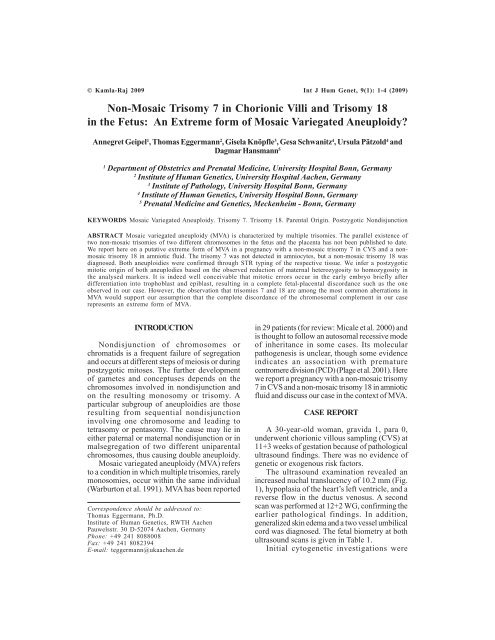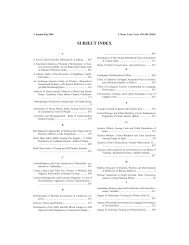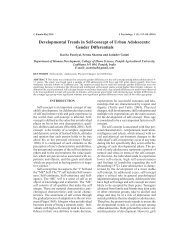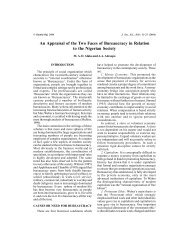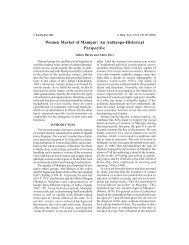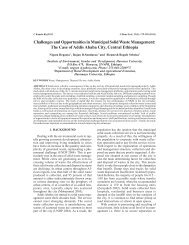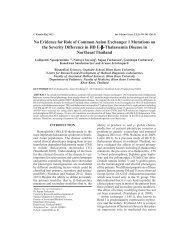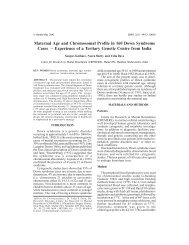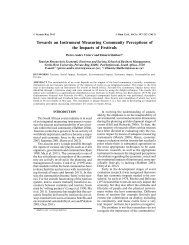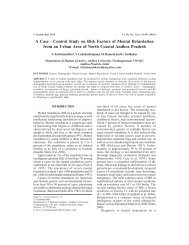Non-Mosaic Trisomy 7 in Chorionic Villi and Trisomy 18 - Kamla-Raj ...
Non-Mosaic Trisomy 7 in Chorionic Villi and Trisomy 18 - Kamla-Raj ...
Non-Mosaic Trisomy 7 in Chorionic Villi and Trisomy 18 - Kamla-Raj ...
Create successful ePaper yourself
Turn your PDF publications into a flip-book with our unique Google optimized e-Paper software.
© <strong>Kamla</strong>-<strong>Raj</strong> 2009 Int J Hum Genet, 9(1): 1-4 (2009)<br />
<strong>Non</strong>-<strong>Mosaic</strong> <strong>Trisomy</strong> 7 <strong>in</strong> <strong>Chorionic</strong> <strong>Villi</strong> <strong>and</strong> <strong>Trisomy</strong> <strong>18</strong><br />
<strong>in</strong> the Fetus: An Extreme form of <strong>Mosaic</strong> Variegated Aneuploidy?<br />
Annegret Geipel 1 , Thomas Eggermann 2 , Gisela Knöpfle 3 , Gesa Schwanitz 4 , Ursula Pätzold 4 <strong>and</strong><br />
Dagmar Hansmann 5<br />
1<br />
Department of Obstetrics <strong>and</strong> Prenatal Medic<strong>in</strong>e, University Hospital Bonn, Germany<br />
2<br />
Institute of Human Genetics, University Hospital Aachen, Germany<br />
3<br />
Institute of Pathology, University Hospital Bonn, Germany<br />
4<br />
Institute of Human Genetics, University Hospital Bonn, Germany<br />
5<br />
Prenatal Medic<strong>in</strong>e <strong>and</strong> Genetics, Meckenheim - Bonn, Germany<br />
KEYWORDS <strong>Mosaic</strong> Variegated Aneuploidy. <strong>Trisomy</strong> 7. <strong>Trisomy</strong> <strong>18</strong>. Parental Orig<strong>in</strong>. Postzygotic <strong>Non</strong>disjunction<br />
ABSTRACT <strong>Mosaic</strong> variegated aneuploidy (MVA) is characterized by multiple trisomies. The parallel existence of<br />
two non-mosaic trisomies of two different chromosomes <strong>in</strong> the fetus <strong>and</strong> the placenta has not been published to date.<br />
We report here on a putative extreme form of MVA <strong>in</strong> a pregnancy with a non-mosaic trisomy 7 <strong>in</strong> CVS <strong>and</strong> a nonmosaic<br />
trisomy <strong>18</strong> <strong>in</strong> amniotic fluid. The trisomy 7 was not detected <strong>in</strong> amniocytes, but a non-mosaic trisomy <strong>18</strong> was<br />
diagnosed. Both aneuploidies were confirmed through STR typ<strong>in</strong>g of the respective tissue. We <strong>in</strong>fer a postzygotic<br />
mitotic orig<strong>in</strong> of both aneuplodies based on the observed reduction of maternal heterozygosity to homozygosity <strong>in</strong><br />
the analysed markers. It is <strong>in</strong>deed well conceivable that mitotic errors occur <strong>in</strong> the early embryo briefly after<br />
differentiation <strong>in</strong>to trophoblast <strong>and</strong> epiblast, result<strong>in</strong>g <strong>in</strong> a complete fetal-placental discordance such as the one<br />
observed <strong>in</strong> our case. However, the observation that trisomies 7 <strong>and</strong> <strong>18</strong> are among the most common aberrations <strong>in</strong><br />
MVA would support our assumption that the complete discordance of the chromosomal complement <strong>in</strong> our case<br />
represents an extreme form of MVA.<br />
INTRODUCTION<br />
<strong>Non</strong>disjunction of chromosomes or<br />
chromatids is a frequent failure of segregation<br />
<strong>and</strong> occurs at different steps of meiosis or dur<strong>in</strong>g<br />
postzygotic mitoses. The further development<br />
of gametes <strong>and</strong> conceptuses depends on the<br />
chromosomes <strong>in</strong>volved <strong>in</strong> nondisjunction <strong>and</strong><br />
on the result<strong>in</strong>g monosomy or trisomy. A<br />
particular subgroup of aneuploidies are those<br />
result<strong>in</strong>g from sequential nondisjunction<br />
<strong>in</strong>volv<strong>in</strong>g one chromosome <strong>and</strong> lead<strong>in</strong>g to<br />
tetrasomy or pentasomy. The cause may lie <strong>in</strong><br />
either paternal or maternal nondisjunction or <strong>in</strong><br />
malsegregation of two different uniparental<br />
chromosomes, thus caus<strong>in</strong>g double aneuploidy.<br />
<strong>Mosaic</strong> variegated aneuploidy (MVA) refers<br />
to a condition <strong>in</strong> which multiple trisomies, rarely<br />
monosomies, occur with<strong>in</strong> the same <strong>in</strong>dividual<br />
(Warburton et al. 1991). MVA has been reported<br />
Correspondence should be addressed to:<br />
Thomas Eggermann, Ph.D.<br />
Institute of Human Genetics, RWTH Aachen<br />
Pauwelsstr. 30 D-52074 Aachen, Germany<br />
Phone: +49 241 8088008<br />
Fax: +49 241 8082394<br />
E-mail: teggermann@ukaachen.de<br />
<strong>in</strong> 29 patients (for review: Micale et al. 2000) <strong>and</strong><br />
is thought to follow an autosomal recessive mode<br />
of <strong>in</strong>heritance <strong>in</strong> some cases. Its molecular<br />
pathogenesis is unclear, though some evidence<br />
<strong>in</strong>dicates an association with premature<br />
centromere division (PCD) (Plage et al. 2001). Here<br />
we report a pregnancy with a non-mosaic trisomy<br />
7 <strong>in</strong> CVS <strong>and</strong> a non-mosaic trisomy <strong>18</strong> <strong>in</strong> amniotic<br />
fluid <strong>and</strong> discuss our case <strong>in</strong> the context of MVA.<br />
CASE REPORT<br />
A 30-year-old woman, gravida 1, para 0,<br />
underwent chorionic villous sampl<strong>in</strong>g (CVS) at<br />
11+3 weeks of gestation because of pathological<br />
ultrasound f<strong>in</strong>d<strong>in</strong>gs. There was no evidence of<br />
genetic or exogenous risk factors.<br />
The ultrasound exam<strong>in</strong>ation revealed an<br />
<strong>in</strong>creased nuchal translucency of 10.2 mm (Fig.<br />
1), hypoplasia of the heart’s left ventricle, <strong>and</strong> a<br />
reverse flow <strong>in</strong> the ductus venosus. A second<br />
scan was performed at 12+2 WG, confirm<strong>in</strong>g the<br />
earlier pathological f<strong>in</strong>d<strong>in</strong>gs. In addition,<br />
generalized sk<strong>in</strong> edema <strong>and</strong> a two vessel umbilical<br />
cord was diagnosed. The fetal biometry at both<br />
ultrasound scans is given <strong>in</strong> Table 1.<br />
Initial cytogenetic <strong>in</strong>vestigations were
2 ANNEGRET GEIPEL, THOMAS EGGERMANN, GISELA KNÖPFLE ET AL.<br />
a<br />
b<br />
c<br />
d<br />
Fig. 1. a) Fetus at 11+3 WG; note the <strong>in</strong>creased nuchal translucency (NT=10.2mm). b) Transverse section<br />
through the fetal abdomen (WG 12+2) demonstrat<strong>in</strong>g pronounced sk<strong>in</strong> oedema. c) Transvag<strong>in</strong>al<br />
ultrasound shows an extreme nuchal translucency (WG 12+2). d) Four-chamber view of the heart (WG<br />
12+2).Flow only observed <strong>in</strong> the right ventricle.<br />
Table 1: Developmental peculiarities of the fetus as documented by ultrasound.<br />
*fetal measurements compared with normal mean values <strong>and</strong> 5 th /95 th percentile)<br />
Biometry 11+3 WG 12+2 WG<br />
m m Percentile* m m Percentile*<br />
Crown-rump length (CRL) 44.8 56.0<br />
Biparietal diameter (BPD) 17.0 20.0<br />
Frontooccipital diameter (FOD) 22.0 26.0<br />
Head circumference (HC) 64.4 72.3<br />
Femur length (FL) 5.9 6.8<br />
Abdom<strong>in</strong>al circumference (AC) 50.5 49.2<br />
Nuchal translucency (NT) 10.2 13.5<br />
Nasal bone (NB) Visible (2.4)<br />
(WG - weeks of gestation)
NON-MOSAIC TRISOMY 7 IN CHORIONIC VILLI AND TRISOMY <strong>18</strong> IN THE FETUS 3<br />
performed <strong>in</strong> the extraembryonic tissue of the<br />
conceptus: <strong>in</strong> uncultured CVS cells, a non-mosaic<br />
trisomy 7 (47,XX,+7) was detected <strong>in</strong> 11 metaphases<br />
by GTG b<strong>and</strong><strong>in</strong>g. This observation was<br />
confirmed by <strong>in</strong>terphase FISH <strong>in</strong> 30 nuclei.<br />
Analysis of 15 metaphases after long term culture<br />
(7 <strong>and</strong> 13 days) confirmed the trisomy 7. There<br />
was no evidence for mosaicism or other<br />
aneuplodies (Table 2).<br />
Based on the karyotype <strong>and</strong> the ultrasound<br />
f<strong>in</strong>d<strong>in</strong>gs, the parents decided on term<strong>in</strong>ation of<br />
pregnancy (TOP) after nondirective genetic<br />
counsell<strong>in</strong>g.<br />
Amniotic fluid was drawn before TOP at 12+2<br />
WG to determ<strong>in</strong>e the fetal karyotype,. In contrast<br />
to the cytogenetic f<strong>in</strong>d<strong>in</strong>gs after CVS, trisomy 7<br />
was not detected <strong>in</strong> amniocytes. However, after<br />
10 days of cultivation spreads of GTG-b<strong>and</strong>ed<br />
chromosomes <strong>and</strong> FISH of <strong>in</strong>terphase nuclei were<br />
analysed <strong>and</strong> non-mosaic trisomy <strong>18</strong> was<br />
diagnosed based on 6 metaphases (GTG) <strong>and</strong> 50<br />
<strong>in</strong>terphases, respectively (Table 2). Premature<br />
centromere division (PCD) was not observed <strong>in</strong><br />
either CVS cells or amniocytes, although, due to<br />
the small numbers of analysed mitoses, it cannot<br />
be excluded.<br />
Pathologic <strong>in</strong>vestigation after term<strong>in</strong>ation of<br />
pregnancy showed a generalized edema of the fetal<br />
sk<strong>in</strong>, dolichocephalus, a hypoplastic left ventricle,<br />
a wrist drop <strong>in</strong> the right h<strong>and</strong> <strong>and</strong> a two vessel<br />
umbilical cord. The placenta was characterized by<br />
hydropic swell<strong>in</strong>g of the villi, reduced<br />
vascularization, <strong>and</strong> calibre differences of the<br />
villous tree. The trophoblast consisted of 2 cell<br />
layers, which were particularly reduced <strong>in</strong> height.<br />
Short t<strong>and</strong>em repeat (STR) typ<strong>in</strong>g was<br />
performed <strong>and</strong> confirmed each aneuploidy <strong>in</strong> the<br />
respective tissue (Table 3). In DNA isolated from<br />
a CVS culture, typ<strong>in</strong>g of chromosome 7 markers<br />
Table 3: Results of STR typ<strong>in</strong>g <strong>in</strong> chorionic <strong>and</strong><br />
amniotic DNA from our case: trisomy 7 <strong>in</strong> CVS<br />
<strong>and</strong> trisomy <strong>18</strong> <strong>in</strong> amniocytes. Maternal alleles<br />
duplicated <strong>in</strong> the fetus, thus correspond<strong>in</strong>g to a<br />
trisomy, are pr<strong>in</strong>ted <strong>in</strong> boldface. (n.a. not analysed)<br />
STR Father Mother chorionic amniovilli<br />
cytes<br />
D7S493 193-212 212-214 193-214 193-214<br />
D7S483 165-174 167-178 167-174 167-174<br />
D7S460 174-<strong>18</strong>2 178 178-<strong>18</strong>2 178-<strong>18</strong>2<br />
D7S2251 146-164 158-166 164-166 164-166<br />
D7S636 132-149 147-163 147-149 147-149<br />
D7S2446 <strong>18</strong>3-191 199-204 <strong>18</strong>3-204 <strong>18</strong>3-204<br />
D7S2452 192 192-200 192 192<br />
D7S17B 146 146 146 146<br />
D<strong>18</strong>S461 160-162 162 160-162 160-162<br />
D<strong>18</strong>S70 230-240 232-238 232-240 232-240<br />
D<strong>18</strong>S390 160-166 164-166 160-164 160-164<br />
D<strong>18</strong>S535 127 130 n.a. 127-130<br />
revealed two alleles with different <strong>in</strong>tensities,<br />
support<strong>in</strong>g the cytogenetic diagnosis of trisomy<br />
7. In amniotic fluid cells, analyses of chromosome<br />
<strong>18</strong> STRs also showed two alleles with different<br />
<strong>in</strong>tensities, consistent with the cytogenetic<br />
diagnosis of trisomy <strong>18</strong>. In all <strong>in</strong>formative markers<br />
the maternally <strong>in</strong>herited allele was markedly<br />
stronger than the paternal one. The occurrence<br />
of three different alleles, which would <strong>in</strong>dicate a<br />
meiotic formation mechanism of the aneuploidies,<br />
was never observed. Instead, the reduction of<br />
maternal heterozygosity to homozygosity <strong>in</strong> all<br />
markers provides evidence for a postzygotic<br />
nondisjunctional error. There was no <strong>in</strong>dication<br />
of cells trisomic for chromosome 7 <strong>in</strong> the amniotic<br />
fluid cells, nor was there any evidence of trisomy<br />
<strong>18</strong> cells <strong>in</strong> the CVS sample, either.<br />
Typ<strong>in</strong>g of STR markers on chromosomes<br />
other than 7 <strong>and</strong> <strong>18</strong> confirmed that the DNA from<br />
both CVS <strong>and</strong> amniocyte samples orig<strong>in</strong>ated from<br />
the same <strong>in</strong>dividual (data not shown).<br />
Table 2: Frequency of trisomic cell l<strong>in</strong>es <strong>in</strong> chorionic villus <strong>and</strong> amniocyte cell samples analysed by<br />
karyotyp<strong>in</strong>g <strong>and</strong> FISH methods.<br />
*no additional results for chromosome <strong>18</strong>; **decreased hybridisation efficency.<br />
Investigated cell system<br />
CVS (WG 11+3) AC (WG 12+2)<br />
Karyotype Interphase/ Karyotype Interphase/<br />
analysis Metaphase FISH analysis Metaphase FISH<br />
47,XX,+7 n <strong>Trisomy</strong> 7* n 47,XX,+<strong>18</strong> n <strong>Trisomy</strong> 7 <strong>and</strong> <strong>18</strong> n<br />
Direct 100 % 11 86 % 35** - - - - -<br />
preparation<br />
Long term 100 % 15 - - 100 % 38 <strong>Trisomy</strong> 7 0 % 132<br />
cell culture <strong>Trisomy</strong> <strong>18</strong> 91 % 56
4 ANNEGRET GEIPEL, THOMAS EGGERMANN, GISELA KNÖPFLE ET AL.<br />
DISCUSSION<br />
We were only partially able to analyse the<br />
phenotype of our patient due to the early<br />
term<strong>in</strong>ation of the pregnancy <strong>and</strong> to the mode of<br />
term<strong>in</strong>ation. Cl<strong>in</strong>ical features such as early<br />
developmental retardation, heart malformation<br />
<strong>and</strong> sk<strong>in</strong> edema have been diagnosed <strong>in</strong> a number<br />
of autosomal trisomies. However, some features<br />
of the fetus <strong>in</strong> this case are more specific <strong>and</strong><br />
have frequently been observed <strong>in</strong> fetal cases of<br />
trisomy <strong>18</strong> (Sch<strong>in</strong>zel 2001), namely dolichocephalus,<br />
wrist drop, <strong>and</strong> the reduced number of<br />
umbilical cord blood vessels. The pathologic<br />
changes of the chorionic villi are typical for a<br />
number of autosomal trisomies (Lukas et al.<br />
1989).<br />
The postzygotic orig<strong>in</strong> of the trisomy 7 cell<br />
l<strong>in</strong>e <strong>in</strong> our case is <strong>in</strong> accordance with published<br />
f<strong>in</strong>d<strong>in</strong>gs: Studies on trisomy 7 show that it<br />
frequently orig<strong>in</strong>ates from mitotic errors (for<br />
review: (Mergenthaler et al. 2000). Furthermore,<br />
trisomy 7 has repeatedly been reported to be<br />
<strong>in</strong>volved <strong>in</strong> CVS mosaicism (for review: Gardner<br />
<strong>and</strong> Sutherl<strong>and</strong> 2004). In these cases, the<br />
percentage of trisomic cells ranged from 7 to 100%<br />
while the fetus itself carried a normal chromosomal<br />
complement <strong>and</strong> was judged <strong>in</strong>conspicuous,<br />
except for those cases with uniparental<br />
disomy 7 (Mergenthaler et al. 2000).<br />
In contrast, a postzygotic mitotic nondisjunction<br />
has been del<strong>in</strong>eated <strong>in</strong> less than 8%<br />
of cases for trisomy <strong>18</strong> (Bugge et al. 1998); the<br />
majority of trisomies <strong>18</strong> orig<strong>in</strong>ates from a maternal<br />
meiosis II error.<br />
In our case we cannot exclude that both<br />
trisomies developed postzygotically simply by<br />
chance. This would, however, be an extremely rare<br />
event. Instead, we assume that our case represents<br />
the extreme form of MVA. As mentioned<br />
previously, all MVA patients reported thus far have<br />
shown a somatic mosaicism for different chromosomes,<br />
po<strong>in</strong>t<strong>in</strong>g to postzygotic nondisjunction <strong>in</strong><br />
a later stage of embryonic development. However,<br />
it is well conceivable that mitotic errors <strong>in</strong> the early<br />
embryo shortly after differentiation <strong>in</strong>to trophoblast<br />
<strong>and</strong> epiblast might occur, result<strong>in</strong>g <strong>in</strong> a<br />
complete fetal-placental discordance as observed<br />
<strong>in</strong> our case. The observation that trisomies 7 <strong>and</strong><br />
<strong>18</strong> are among the most common aberrations <strong>in</strong><br />
MVA patients further supports our conclusion that<br />
the complete discordance of the chromosomal<br />
complement <strong>in</strong> our case represents the extreme<br />
end of MVA.<br />
REFERENCES<br />
Bugge M, Coll<strong>in</strong>s A, Petersen MB, Fisher J, Br<strong>and</strong>t C,<br />
Hertz JM, Tranebjaerg L, de Lozier-Blanchet C,<br />
Nicolaides P, Brondum-Nielsen K, Morton N,<br />
Mikkelsen M 1998. <strong>Non</strong>-disjunction of trisomy <strong>18</strong>.<br />
Hum Mol Genet, 7: 661-669.<br />
Gardner RJM, Sutherl<strong>and</strong> GR 2004 Chromosome<br />
Abnormalities <strong>and</strong> Genetic Counsell<strong>in</strong>g. 3 rd Edition,<br />
Oxford: Oxford University Press.<br />
Lukas U, Gamerd<strong>in</strong>ger F, Schwanitz G 1989. Growth<br />
retardation of the fetus comb<strong>in</strong>ed with<br />
developmental abnormalities <strong>in</strong> the extraembryonic<br />
tissue <strong>in</strong> correlation with different chromosome<br />
abnormalities. Auxologie, 88: 387-393.<br />
Mergenthaler S, Wollmann HA, Burger B, Eggermann<br />
K, Kaiser P, Ranke MB, Schwanitz G, Eggermann T<br />
2000. Formation of uniparental disomy 7 del<strong>in</strong>eated<br />
from new cases <strong>and</strong> a UPD7 case after trisomy 7<br />
rescue. Ann Génét, 43: 15-21.<br />
Micale MA, Schran D, Emch S, Kurczynski TW, Rahman<br />
N, van Dyke DL 2007. <strong>Mosaic</strong> variegated<br />
aneuploidy without microcephaly: implications for<br />
cytogenetic diagnosis. Am J Med Genet, 143A:<br />
<strong>18</strong>90-<strong>18</strong>93.<br />
Plaja A, Vendrell T, Smeets D, Sarret E, Gili T, Catala V,<br />
Mediano C, Scheres JM 2001. Variegated aneuploidy<br />
related to premature centromere division (PCD) is<br />
expressed <strong>in</strong> vivo <strong>and</strong> is a cancer-prone disease. Am<br />
J Med Genet, 98: 216-223.<br />
Sch<strong>in</strong>zel A 2001. Cataloque of Unbalanced Chromosome<br />
Aberrations <strong>in</strong> Man. 2 nd Edition, Berl<strong>in</strong>, New<br />
York: de Gruyter.<br />
Warburton D, Anyane-Yeboa K, Takerka P, Yu CY, Olsen<br />
D 1991. <strong>Mosaic</strong> variegated aneuploidy with<br />
microcephaly: a new human mitotic mutant. Ann<br />
Génét, 34: 287-292.


